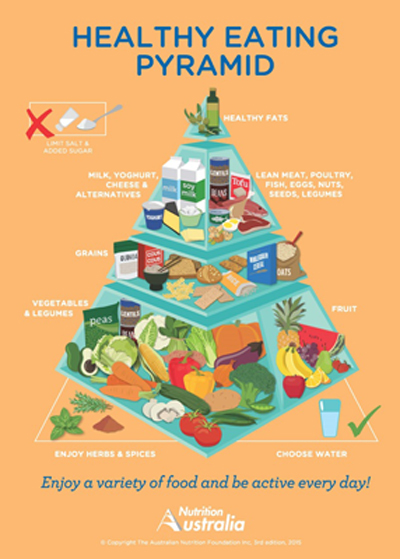
A lot has changed in nutrition in the last 15 years. Fad diets have come and gone and left a trail of confusion in their wake about what constitutes a healthy diet.
To help overcome this and to be more in line with
current guidelines, Nutrition Australia has revamped the healthy eating pyramid for the first time in 15 years.
Nutrition Australia Vic Division, Executive Officer Lucinda Hancock said health professionals are concerned about the overwhelming amount of conflicting and confusing information about food and nutrition.
“The new Pyramid cuts through the misleading information and fad diets that are getting so much attention, and provides Australians with a credible, flexible and realistic guide to eating well,” said Ms Hancock.
“Unfortunately we know that most Australians don’t eat what is recommended by the Pyramid and the Dietary Guidelines, and this is why we’re seeing such high rates of diet-related diseases.
“The latest health survey data shows that the average Australian is getting more than a third of their daily energy intake from junk foods, while less than seven per cent of people eat enough vegetables and only half of us eat enough fruit,“ said Ms Hancock.
“We want to get the message across that for most people the simplest way to eat healthier is to cut down on junk food and sugary drinks and to eat mostly from the core food groups – especially to eat more fruit and vegetables,” said Ms Hancock.
“You don’t need to follow a restrictive diet or cut out entire food groups to eat healthier, because this can also lead to other issues such as yoyo dieting or nutrient deficiencies.”
The healthy eating pyramid- what’s changed?
The previous Pyramid grouped all foods in three layers:
- The Eat Most layer containing plant-based foods (fruit, vegetables, grains, nuts and legumes)
- The Eat Moderately layer containing dairy foods (and dairy alternatives) and meat (and meat alternatives)
- The small top layer with added fats and sugars
The new Pyramid separates each layer into the five specific food groups, to provide clearer information about how much each one contributes to a balanced diet:
- Plant-based foods still take up the largest amount of space, with fruit, vegetables and legumes emphasised in the bottom layer, followed by grain foods, then moderate amounts of dairy and protein foods (lean meat, poultry, fish, eggs, nuts, seeds and legumes)
- Small amounts of healthy fats
- It also encourages drinking water, limiting salt and added sugar, and to enjoy herbs and spices to flavour foods without using salt
Senior Nutritionist Aloysa Hourigan explains the changes to ABC Radio’s David Curnow.



